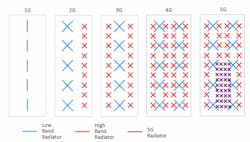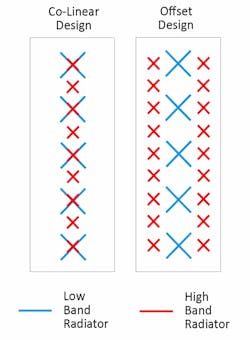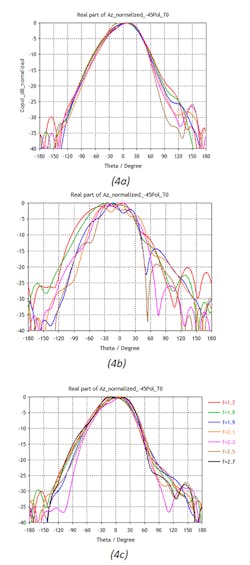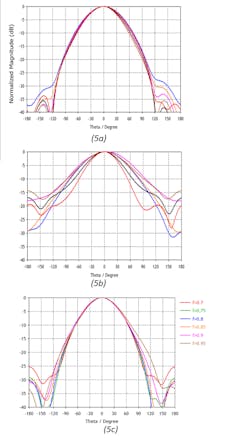This article is part of TechXchange: Antenna Design
Members can download this article in PDF format.
What you’ll learn:
- Why multiband MIMO antenna design presents a roadblock to 4G/5G network optimization.
- How frequency-transparent dipole technology can effectively cloak radiating elements to overcome distortion and interference challenges.
Over nearly 50 years, mobile radio-access-network (RAN) base transceiver station (BTS) antenna technology has advanced from single-frequency-band antennas with a single port to antennas with dozens of ports and multiple frequency bands. All of this technology is now contained within a housing roughly the same size as was used back when public mobile communications networks first started in the 1980s.
This evolution of antenna technology has been driven by the need to overcome the vagaries of radio signal propagation, where there can be multiple signal reflections from the ground and other objects in the natural and built environment, as well as direct or refracted paths that can be partially blocked. These multiple signal paths may combine or cancel out each other, producing an unreliable communications channel.
Advanced antenna design can help overcome this multipath propagation by adding more radiating elements per frequency band—in physically separated or orthogonally polarized arrays that diversify possible signal paths.
Because these elements are fed by different ports on the antenna, they are, in effect, totally isolated channels (that’s the idea, anyway). If one channel is fading, then another may be less affected due to the way the various signals add and subtract over different signal paths and with orthogonal polarizations. This spatial or polarization diversity improves the quality of the received signal because there’s less chance of signals fading when the different channels are combined and processed.
In the more advanced 4G and 5G RAN standards, these multiple ports per band also can be used to send more data to each user, enabling enhanced mobile broadband (eMBB) capabilities. Each channel is able to carry separate data streams, which can then be combined at the receiver with multiple antennas carrying the traffic within the same frequency band using a multiple-input, multiple-output (MIMO) configuration.
However, deploying a greater number of antennas increases wind load, visual pollution, and tower rental costs. Therefore, these multiple antennas should be contained within the same housing. And as the number of antennas increases in a MIMO system, so too does the RF design complexity.
Another driver of RAN antenna technology evolution is the irrepressible demand for more data. As early mobile technology (which had only voice to contend with) has progressed to 5G networks, we’ve added data capability, images, and now high-definition video with increasing data speed requirements.
With more frequency bands continually allocated to meet the demand for bandwidth, large chunks of spectrum are now used for mobile communications between 600 MHz and 6 GHz. The need for multiple frequency bands to be deployed has meant that radiating elements and their associated feed networks must be provided for each of these bands.
Furthermore, many government authorities and the public demand that BTS antennas don’t grow bigger in size and proliferate on towers. These radiating elements from multiple frequency bands now must coexist in the same space within the antenna.
BTS Antenna Evolution
The challenge of adding new frequency bands and multiple ports to antennas, while maintaining antenna size through successive generations, has kept antenna designers very busy. Figure 1 illustrates the evolution of the technology from 1G to 4G and 5G, showing diagrammatically the arrays of radiating elements within each antenna generation.
The diagrams show each radiating element as a short line, representing the polarization of the element. The elements are commonly arrayed vertically to increase the aperture of the antenna in the vertical direction and therefore compress the beamwidth along this axis.
For 1G technology, the antenna had only one port, in the 800/900-MHz band, and each element was just singly polarized—normally vertical linear polarization provided by a dipole or patch. For the second generation of mobile technology, a higher-frequency band was added in the 1800/1900-MHz range, and polarization diversity was included to combat multipath fading. Arrays from the two frequency bands were normally separated in the antenna to prevent them from interfering with each other—a common problem that we still need to address today.
For the advent of 3G and 4G, both low- and high-frequency bands were extended to provide greater bandwidth. More low- and high-band arrays also were added to provide more ports for the various sub-bands—for instance, the 1800-MHz band could be accommodated on separate ports from the 2100-MHz band. On top of that, more ports were required for MIMO operation.
This created the problem of having nowhere to put the extra arrays without increasing antenna size, necessitating the technique of interleaving low- and high-band elements. Because it involves using the same space to accommodate radiating elements from both low and high bands, the elements must be physically arranged so that they don’t interfere with each other both mechanically and electrically.
5G brought new frequency bands and more sophisticated technology. The new bands can be incorporated into the same antennas that use 3G/4G, but they’re often deployed in separate antennas due to the increased complexity of the technology.
Multiband Complexity
To achieve the interleaving of radiating elements from different bands, antenna vendors have employed two separate approaches to attempt to solve the problem of mechanical and electrical interference. One approach involves arranging the radiating elements from each band in a co-linear fashion (Fig. 2, left), but this requires that the higher-band elements are an integral multiple of the low-band elements—commonly two. This relationship depends on the ratio of the wavelengths for each band and doesn’t always work out; these bands have been extended as the generations evolved. The result: compromises in antenna performance.
A second approach (Fig. 2, right) arranges the higher-band arrays alongside the low-band array(s). With this technique, the high-band arrays can be designed independently of the low-band array(s), and the spacings between the elements in the array can be individually optimized for each band.
However, regardless of how the low- and high-band elements are arranged physically, it’s possible that the high-band elements can become resonant at the low band. That’s difficult to combat when both the high- and low-band elements must operate over a very wide band.
For instance, the low-band elements are commonly required to operate from 698 to 960 MHz and the high-band elements from 1695 to 2690 MHz. It becomes a struggle to move the resonant behavior of the high-band element out of the low band while keeping the dipole operating properly at its own high band.
When the high-band dipole becomes resonant at the low band, it can significantly impact the radiation pattern of the low band, particularly the azimuth pattern (horizontal plane) when the high-band dipoles are displaced in the azimuth direction.
These extra resonator sources add to the signal radiated from the low-band dipoles and disrupt their pattern. This isn’t acceptable in a mobile network where azimuth beamwidth must be well controlled and signal propagated outside an antenna’s own sector needs to be minimized to avoid co-channel interference, which leads to poor quality of service (QoS).
Another problem stemming from interleaving of low- and high-band arrays is that the low-band dipoles can scatter high-band signal because they’re electrically large at the high-band frequencies. As the signals are scattered and antenna efficiency is reduced, its radiation pattern becomes disrupted.
Frequency-Transparent Cloaking
So how can antenna manufacturers tackle these common problems in an interleaved multiband antenna? One approach to designing interleaved multiband antennas is Alpha Wireless’s frequency-transparent dipole technology (FTDT). When using FTDT, multiple antenna arrays for both the same and different bands can be packed into one space without compromising the performance of each array.
First, for the low-band dipoles, coupled-resonator filters were introduced onto their radiating arms, which extend over the top of the high-band elements and can cause serious scattering of the high-band signals. These filters allow for low-band current to pass unimpeded along the arms but block high-band currents from propagating. If the high-band currents are suppressed on the low-band arms, there’s less scattering, and the low-band arms look more transparent to the high band. This results in less distortion to the low-band radiation patterns.
Figure 3 shows high-band current flow on the low-band dipole arms when the high-band dipoles are radiating. It shows the high-band currents when there’s no filtering on the low-band dipole arms (Fig. 3a) and the currents after introduction of resonator filters (Fig. 3b). Blue coloring indicates low signal level, with green being stronger.
It’s evident from the figures that high-band current is suppressed by the filters. Also, propagation along the low-band dipole arms is blocked where the filters are located and only circulates within them.
Figure 4 shows the effect on the antenna’s high-band azimuth pattern by the introduction of filtering on the low-band dipole arms. Figure 4a demonstrates high-band radiators without any low-band dipoles present, Figure 4b adds low-band dipoles without filters, and Figure 4c is with filtered low-band dipole arms. Pattern distortion is greatly reduced with the filters present, and the original high-band pattern is nearly recovered.
The resonator filters help the high-band patterns immensely, but they’re awkward for the low band because they disrupt the tuning of the low-band dipoles. This means the low-band dipoles are harder to impedance-match and return loss will be worse, meaning more signal is undesirably reflected to the input of the antenna.
Therefore, the design task for antenna engineers has an added dimension in that the degree of filtering, and the low-band return loss, are tradeoffs and the best compromise must be met. Significant simulation and testing must be undertaken before reaching the optimized state.
Having solved the interaction between the low-band dipole arms and high-band signals by making the low-band dipoles “frequency transparent” at the high band, antenna design engineers still needed to solve the previously mentioned resonant behavior of the high-band dipole at the low-band frequency. These are completely independent problems requiring different solutions.
Common-Mode Resonance
The high-band dipoles are designed to resonate at the high band, which is why they radiate and act as the transducers that convert signal propagating along a transmission line, like a coaxial cable, into electromagnetic waves.
The resonant frequency of the dipoles depends on their physical size in wavelengths. Therefore, if the dipoles are designed to be a certain size to suit the high band, one may wonder how they could resonate at a much lower frequency. To resonate at the much lower frequency band, the dipoles should be much bigger.
In normal operation, only the dipole arms radiate EM energy. Unshielded or unbalanced signal propagating along the dipole’s supporting structure should be avoided, otherwise this will radiate as well in an uncontrolled and undesirable fashion.
With the before-mentioned typical frequency relationship between the commonly used bands in mobile communications—698 to 960 MHz for the low band and 1695 to 2690 MHz for the high band—an unfortunate situation arises: The total size of the high-band dipole, including the dipole arms and supporting structure that contains the matching balun, can become resonant at the low band much like a monopole.
This resonance is a result of the direct frequency ratio of the low and high bands and is very difficult to avoid. This occurrence is termed a “common mode” because all parts of the dipole contain signal propagating in a common direction, from the dipole-arm tips to the ground plane where the dipole supporting structure is connected. Since the whole high-band dipole structure is conducting signal like a monopole at the low-band frequency, it will radiate and add an undesirable signal source to the antenna that disrupts the low-band radiation patterns.
Alpha Wireless’s engineers devised several different means to combat the common-mode low-band resonance in the high-band dipoles, depending on the exact frequency relationship required between the low and high bands. These methods push the resonance frequency either up or down and out of the low-band frequency range.
In fact, the FTDT method uses the resonant frequency as an advantage to improve the low-band radiation patterns by selecting its location precisely using some aspects of the high-band dipole’s signal-feeding arrangement. The technology provides a way to do this without disrupting the high-band dipole’s own impedance matching, which often suffers when tackling such a common-mode problem.
The ability to improve the low-band radiation patterns is particularly important for the design of slim, multiband tri-sector antennas with a diameter of only 360 mm. It enables the common-mode frequency’s position to be used to maximum effect to optimize the azimuth patterns, which are otherwise compromised due to the smaller diameter than optimum for this band.
Figure 5 shows the effect on the low-band patterns of introducing these common-mode design techniques to the high-band dipoles. Evidently, the common-mode resonance can severely disrupt the low-band patterns, but the FTDT method addresses the problem (Fig. 5c). In this way, we have successfully tackled the complexities encountered when interleaving radiating arrays from multiple frequency bands in one antenna: Using resonator filters on the low-band dipole arms and modifying the high-band dipole feed network shifted common-mode resonances out of the low band.
Conclusion
Mobile communications networks have become a ubiquitous digital infrastructure that enables our hyper-connected global society. As the subscribers’ first point of contact with these networks, antenna technology plays a pivotal role in ensuring QoS.
The ever-increasing demand for bandwidth is driving a transformation in antenna technology, requiring multiple arrays of radiating elements at different frequency bands to operate together in one unobtrusive antenna design without interfering with each other. Yet, the various interactions between the radiating elements of each band can wreak havoc with radiation patterns, which has negative repercussions on network performance and customer experience.
To address this significant RF design challenge, Alpha Wireless developed frequency-transparent dipole technology. With the capability to enable exceptional radiation-pattern performance in even the smallest diameter tri-sector antennas, this design technology helps pave the way to greater mobile network speed, capacity, and performance.
Read more articles in TechXchange: Antenna Design





